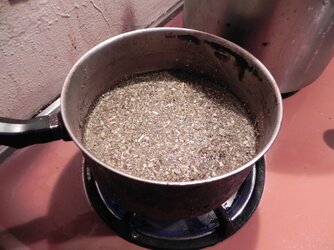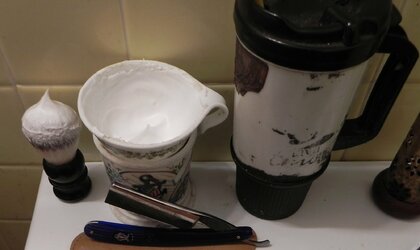CzechCzar
Use the Fat, Luke!
Introduction - Yerba Mate
I have been meaning to write this for a long time, so buckle up! This will be a long post.
Picture yourself, 17 years old, transported to the South American pueblo. The village you are living in has only a few hundred people in it. There is a single, bumpy, dirt road that leads into the nearest town, but no one has a car. You are lucky, in that there is a water tower nearby your host family’s house, so you are able to take ice-cold showers, rather than having to resort to a bucket-bath every few days.
You wake up with the chickens, right at dawn. After milking the cows - the first order of business - your host family sits around the fire pit, warming themselves in the still-frigid morning air. A kettle is placed on the fire, and then your host-brother takes out something you have never seen.
It looks vaguely illicit to your American eyes, but you know from your volunteer training what it is. Now you are to be inculcated into the great ritual.

If British have tea, and the rest of Europe has coffee, South America (specifically Argentina, Paraguay, Uruguay, and Brazil) has Yerba Mate. The practice of drinking (taking, tomar, in Spanish) mate is much, much more important in South America than that of drinking coffee or tea. While we imbibe to shake off the cobwebs of too-little-sleep, or to get an energetic start to our day, yerba mate is inseparable from people and culture. In short, mate breaks social barriers. It is shared among people from different classes, with different political viewpoints, from different generations. Mate makes todos juntos. Mate is a vital part of life.
Yerba mate is not technically a tea. Rather, it comes from a tree in the Holly family called ilex paraguayensis. The Guarani natives of Paraguay consumed yerba mate for medicinal purposes and introduced it to the Spaniards – recent immigrants – who initially condemned it.
Pre-Columbian Origins: A Guaraní Legacy
The narrative of yerba mate begins in the heart of South America, where the Guaraní people, inhabitants of present-day Paraguay, northeastern Argentina, and southern Brazil, first discovered the wonders of this remarkable plant. Steeped in mythology and tradition, the Guaraní revered yerba mate as a sacred gift from the gods, a source of nourishment, energy, and spiritual connection.
Legends recount the tale of Tupã, the supreme deity, who bestowed upon the Guaraní people a tree with emerald leaves capable of alleviating fatigue and promoting harmony. The Guaraní embraced this divine offering, incorporating yerba mate into their daily lives, utilizing it for medicinal purposes, and incorporating it into their social and spiritual gatherings.

“By 1596 the consumption of mate as a beverage had become so common in Paraguay that a member of the cabildo of Asunción wrote to governor of Río de la Plata Hernando Arias de Saavedra:
‘[T]he vice and bad habit of drinking yerba has spread so much among the Spaniards, their women and children, that unlike the Indians that are content to drink it once a day they drink it continuously and those who do not drink it are very rare.’
“The same author of the letter went on to claim that Spanish settlers sold their clothing, weapons and horses or fell into debt to obtain yerba mate.[5]”
Clearly there was skepticism about yerba made by the authorities. Equally clear is that the Spanish were adopting the habits of the natives.
European Encounters: A Tale of Exploration and Adaptation
The arrival of European explorers in the 16th century marked a pivotal moment in the history of yerba mate. Intrigued by the indigenous consumption of this unique beverage, the Spanish conquistadores documented their observations, introducing yerba mate to the wider world.
Initially met with skepticism and even disapproval by some European authorities, yerba mate gradually gained acceptance, particularly among the Jesuit missionaries who arrived in South America. Recognizing its potential benefits, the Jesuits began cultivating yerba mate, establishing plantations and refining production techniques.

The Rise of Yerba Mate: A Cultural Phenomenon
As the centuries unfolded, yerba mate transcended its indigenous roots and permeated the broader South American society. Its consumption became widespread, particularly in Paraguay, Argentina, Uruguay, and southern Brazil, where it evolved into a cultural emblem, a symbol of camaraderie, and a cornerstone of daily life.
Gauchos, the skilled horsemen of the South American grasslands, embraced yerba mate as their constant companion, a source of warmth and energy during long days on the range. The beverage became synonymous with hospitality, shared among friends and family, fostering a sense of community and connection.
Modern Renown: A Global Embrace
In the modern era, yerba mate has transcended geographical boundaries, gaining recognition and popularity worldwide. Its unique flavor profile, coupled with its purported health benefits, has attracted a growing global audience eager to experience the invigorating effects of this ancient beverage.
Scientific research has delved into the potential health benefits of yerba mate, exploring its antioxidant properties, its potential role in boosting energy levels and cognitive function, and its possible contribution to cardiovascular health. While further studies are needed to fully elucidate these effects, the growing body of research has further fueled interest in yerba mate.
The Enduring Legacy of Yerba Mate
Yerba mate stands as a testament to the enduring power of tradition and the ability of a simple beverage to transcend cultures and generations. From its humble origins among the Guaraní people to its global reach in the modern world, yerba mate continues to weave its captivating story, connecting individuals and communities through its unique flavor and invigorating essence.
Cultural Significance
In South America, consumption of mate is an inherently social ritual.
The preparation and consumption of yerba mate follow a set of customs that foster community and equality. The person who prepares and serves the mate is called the cebador or cebadora. They fill the gourd with dried yerba leaves, add hot water, and pass it to each person in the group. Each participant drinks until the gourd is empty, returns it to the server, who refills it and passes it to the next person. This cycle promotes a sense of unity and egalitarianism, as everyone shares from the same gourd.



In Argentina, yerba mate is a symbol of friendship and hospitality. It’s common to see people carrying their mate and thermos, ready to share a moment with friends or strangers alike. In Uruguay, mate has such a strong presence that it’s not unusual to see people enjoying it in public spaces, at work, or while walking down the street. Paraguayans often prefer their mate ice-cold, calling it tereré, to combat the heat of the tropical climate.

Preparing The Yerba Mate Tea
Process of preparing mate
5 tips to remember
I have been meaning to write this for a long time, so buckle up! This will be a long post.
Picture yourself, 17 years old, transported to the South American pueblo. The village you are living in has only a few hundred people in it. There is a single, bumpy, dirt road that leads into the nearest town, but no one has a car. You are lucky, in that there is a water tower nearby your host family’s house, so you are able to take ice-cold showers, rather than having to resort to a bucket-bath every few days.
You wake up with the chickens, right at dawn. After milking the cows - the first order of business - your host family sits around the fire pit, warming themselves in the still-frigid morning air. A kettle is placed on the fire, and then your host-brother takes out something you have never seen.
It looks vaguely illicit to your American eyes, but you know from your volunteer training what it is. Now you are to be inculcated into the great ritual.

If British have tea, and the rest of Europe has coffee, South America (specifically Argentina, Paraguay, Uruguay, and Brazil) has Yerba Mate. The practice of drinking (taking, tomar, in Spanish) mate is much, much more important in South America than that of drinking coffee or tea. While we imbibe to shake off the cobwebs of too-little-sleep, or to get an energetic start to our day, yerba mate is inseparable from people and culture. In short, mate breaks social barriers. It is shared among people from different classes, with different political viewpoints, from different generations. Mate makes todos juntos. Mate is a vital part of life.
Yerba mate is not technically a tea. Rather, it comes from a tree in the Holly family called ilex paraguayensis. The Guarani natives of Paraguay consumed yerba mate for medicinal purposes and introduced it to the Spaniards – recent immigrants – who initially condemned it.
Pre-Columbian Origins: A Guaraní Legacy
The narrative of yerba mate begins in the heart of South America, where the Guaraní people, inhabitants of present-day Paraguay, northeastern Argentina, and southern Brazil, first discovered the wonders of this remarkable plant. Steeped in mythology and tradition, the Guaraní revered yerba mate as a sacred gift from the gods, a source of nourishment, energy, and spiritual connection.
Legends recount the tale of Tupã, the supreme deity, who bestowed upon the Guaraní people a tree with emerald leaves capable of alleviating fatigue and promoting harmony. The Guaraní embraced this divine offering, incorporating yerba mate into their daily lives, utilizing it for medicinal purposes, and incorporating it into their social and spiritual gatherings.

“By 1596 the consumption of mate as a beverage had become so common in Paraguay that a member of the cabildo of Asunción wrote to governor of Río de la Plata Hernando Arias de Saavedra:
‘[T]he vice and bad habit of drinking yerba has spread so much among the Spaniards, their women and children, that unlike the Indians that are content to drink it once a day they drink it continuously and those who do not drink it are very rare.’
“The same author of the letter went on to claim that Spanish settlers sold their clothing, weapons and horses or fell into debt to obtain yerba mate.[5]”
Clearly there was skepticism about yerba made by the authorities. Equally clear is that the Spanish were adopting the habits of the natives.
European Encounters: A Tale of Exploration and Adaptation
The arrival of European explorers in the 16th century marked a pivotal moment in the history of yerba mate. Intrigued by the indigenous consumption of this unique beverage, the Spanish conquistadores documented their observations, introducing yerba mate to the wider world.
Initially met with skepticism and even disapproval by some European authorities, yerba mate gradually gained acceptance, particularly among the Jesuit missionaries who arrived in South America. Recognizing its potential benefits, the Jesuits began cultivating yerba mate, establishing plantations and refining production techniques.
The Rise of Yerba Mate: A Cultural Phenomenon
As the centuries unfolded, yerba mate transcended its indigenous roots and permeated the broader South American society. Its consumption became widespread, particularly in Paraguay, Argentina, Uruguay, and southern Brazil, where it evolved into a cultural emblem, a symbol of camaraderie, and a cornerstone of daily life.
Gauchos, the skilled horsemen of the South American grasslands, embraced yerba mate as their constant companion, a source of warmth and energy during long days on the range. The beverage became synonymous with hospitality, shared among friends and family, fostering a sense of community and connection.
Modern Renown: A Global Embrace
In the modern era, yerba mate has transcended geographical boundaries, gaining recognition and popularity worldwide. Its unique flavor profile, coupled with its purported health benefits, has attracted a growing global audience eager to experience the invigorating effects of this ancient beverage.
Scientific research has delved into the potential health benefits of yerba mate, exploring its antioxidant properties, its potential role in boosting energy levels and cognitive function, and its possible contribution to cardiovascular health. While further studies are needed to fully elucidate these effects, the growing body of research has further fueled interest in yerba mate.
The Enduring Legacy of Yerba Mate
Yerba mate stands as a testament to the enduring power of tradition and the ability of a simple beverage to transcend cultures and generations. From its humble origins among the Guaraní people to its global reach in the modern world, yerba mate continues to weave its captivating story, connecting individuals and communities through its unique flavor and invigorating essence.
Cultural Significance
In South America, consumption of mate is an inherently social ritual.
The preparation and consumption of yerba mate follow a set of customs that foster community and equality. The person who prepares and serves the mate is called the cebador or cebadora. They fill the gourd with dried yerba leaves, add hot water, and pass it to each person in the group. Each participant drinks until the gourd is empty, returns it to the server, who refills it and passes it to the next person. This cycle promotes a sense of unity and egalitarianism, as everyone shares from the same gourd.

In Argentina, yerba mate is a symbol of friendship and hospitality. It’s common to see people carrying their mate and thermos, ready to share a moment with friends or strangers alike. In Uruguay, mate has such a strong presence that it’s not unusual to see people enjoying it in public spaces, at work, or while walking down the street. Paraguayans often prefer their mate ice-cold, calling it tereré, to combat the heat of the tropical climate.

Preparing The Yerba Mate Tea
Process of preparing mate
- Heat the water to 75-80 degrees Celsius. Any hotter and you’ll burn the herb, making it bitter. Once it’s the right heat, pour it into a thermos to keep it that way.
- Grab your mate and fill it a little over halfway with yerba mate.
- Place your hand over the top of the half-filled container. Turn it upside down and give it a bit of a shake to bring the more powdery leaves to the top. This means you won’t be drinking dust.
- Turn the container on its side and give it a few more shakes so the yerba is on a pile on one side.
- It’s bombilla time. Position it so the curved part faces down, and put it close to the wall in the empty space in the container so you don’t disturb the leaves. Add cold water into the empty space until it reaches the top of the powdery maté pile (but keep the top dry). Wait for the water to be absorbed.
- Pour hot water into the empty space just as you did with the cold water, filling the mate up. This is the place you’ll pour water in after every round.
- The person who makes maté — el cebador (the server) — drinks first, so drink from the bombilla until you drink the whole cup. Don’t move the straw, as doing so may clog the filter and you’ll have to start the process again!
- Once you’ve drunk the maté, fill it with hot water — pouring it into the same place you did last time — and hand the cup to the first person to your right. Use the same bombilla. Once that person has drunk the full cup, they’ll hand it back to you.
- Refill the mate and pass it to the next person to the right. Keep passing it around the circle until the herb loses its taste.
5 tips to remember
- El cebador must always drink first, otherwise it can be considered bad manners as the drink may be too cold or too strong.
- To keep drinking maté, don’t say gracias when el cebador hands it to you. Saying thanks signals that you don’t want any more maté.
- Never move the bombilla once it’s inserted. If you jiggle it around, pieces of maté may clog the filter, making you everyone’s least favourite foreigner.
- Don’t boil the water. If it’s any hotter than 80 degrees Celsius, it will burn your mate, making it bitter and unpleasant to drink.
- If you don’t like the flavour of yerba mate, try other variations used by South Americans. Some add honey or sugar, some prepare the tea with cold water, while others mix yerba with other herbs, orange or lemon peel, or even coffee.
Last edited:









